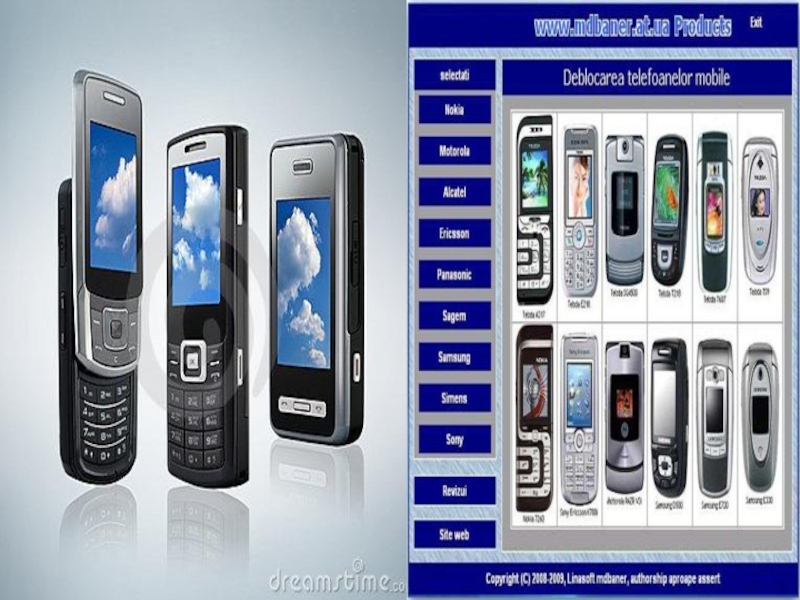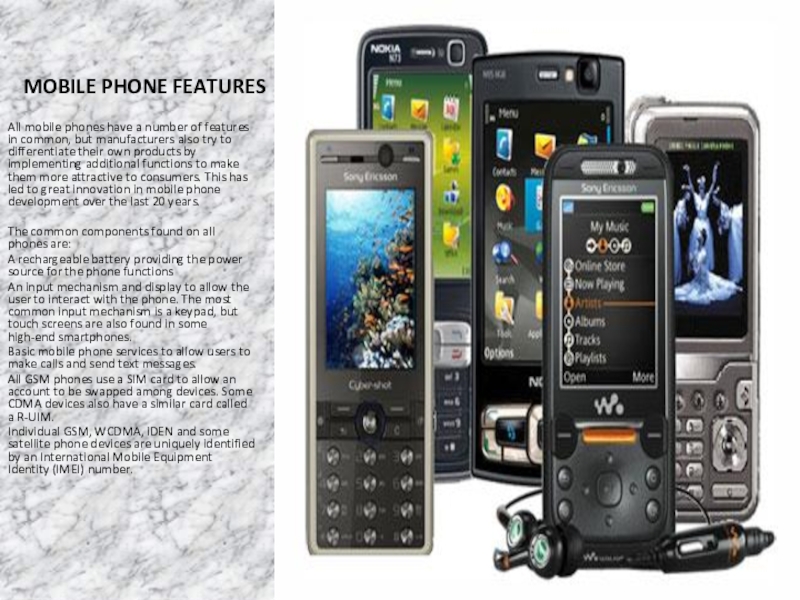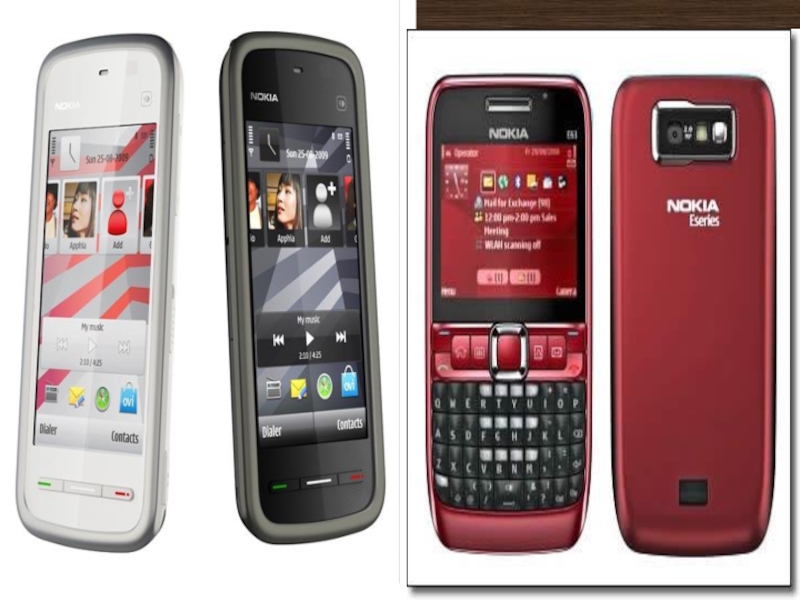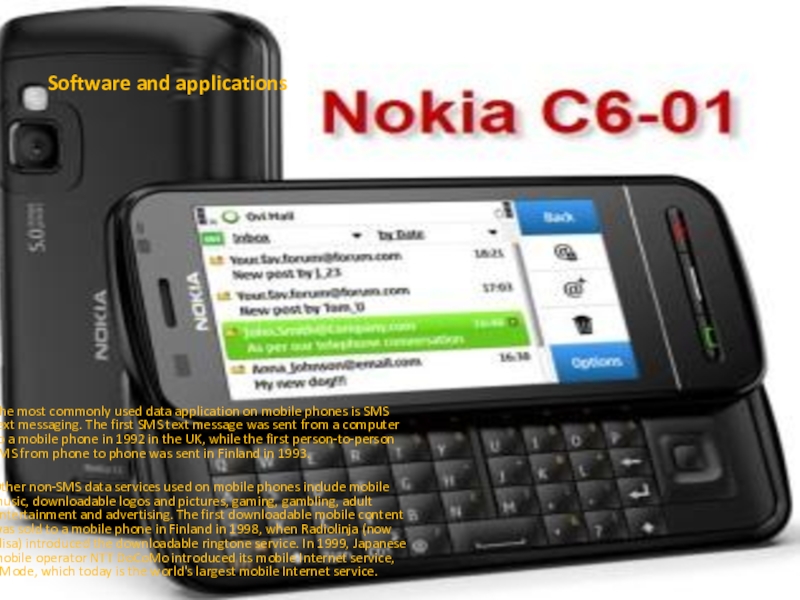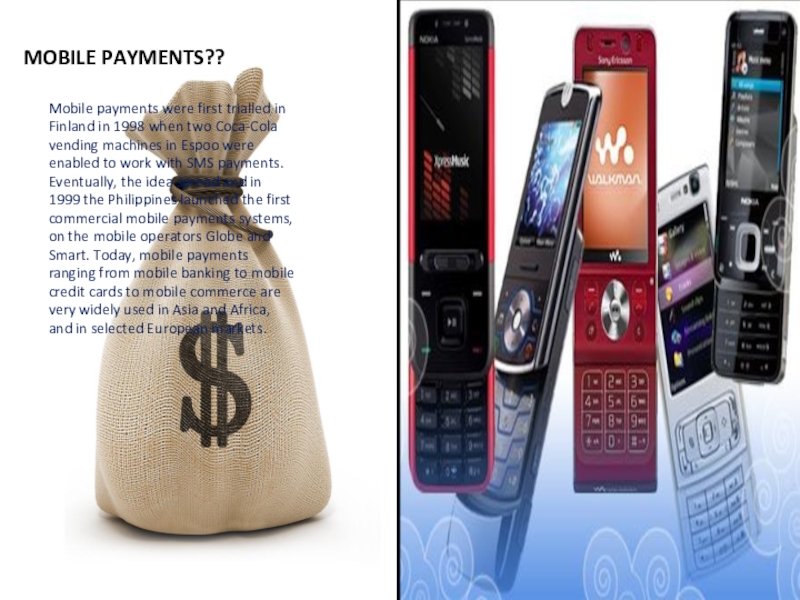- Главная
- Разное
- Образование
- Спорт
- Естествознание
- Природоведение
- Религиоведение
- Французский язык
- Черчение
- Английский язык
- Астрономия
- Алгебра
- Биология
- География
- Геометрия
- Детские презентации
- Информатика
- История
- Литература
- Математика
- Музыка
- МХК
- Немецкий язык
- ОБЖ
- Обществознание
- Окружающий мир
- Педагогика
- Русский язык
- Технология
- Физика
- Философия
- Химия
- Шаблоны, фоны, картинки для презентаций
- Экология
- Экономика
Презентация, доклад на тему In the world of mobile phones
Содержание
- 1. In the world of mobile phones
- 2. A mobile phone (also called mobile, cellular
- 3. FUNCTIONS OF MOBLIE PHONESA mobile phone can
- 4. Слайд 4
- 5. History of mobile phonesThe first mobile telephone
- 6. MOBILE PHONE FEATURESAll mobile phones have a
- 7. Слайд 7
- 8. Software and applications The most commonly used
- 9. MOBILE PAYMENTS?? Mobile payments were first trialled in
- 10. Слайд 10
A mobile phone (also called mobile, cellular telephone, or cell phone) is an electronic device used to make mobile telephone calls across a wide geographic area. Mobile phones differ from cordless telephones, which only offer telephone
Слайд 1IN THE WORLD OF MOBILE PHONES
BY Zhumagaliyeva Bayan
Mirzametova Mashkhura
Muslimova Dinara
Khusanova Nodira
Слайд 2A mobile phone (also called mobile, cellular telephone, or cell phone)
is an electronic device used to make mobile telephone calls across a wide geographic area. Mobile phones differ from cordless telephones, which only offer telephone service within a limited range of a fixed land line, for example within a home or an office. The first handheld mobile phone was demonstrated by Dr. MartiHistory
WHAT IS MOBILE PHONE??
Слайд 3FUNCTIONS OF MOBLIE PHONES
A mobile phone can make and receive telephone
calls to and from the public telephone network which includes other mobiles and fixed-line phones across the world. It does this by connecting to a cellular network owned by a mobile network operator.
In addition to being a telephone, modern mobile phones also support many additional services, and accessories, such as SMS (or text) messages, e-mail, Internet access, gaming, Bluetooth and infrared short range wireless communication, camera, MMS messaging, MP3 player, radio and GPS. Low-end mobile phones are often referred to as feature phones, whereas high-end mobile phones that offer more advanced computing ability are referred to as smartphones.
In addition to being a telephone, modern mobile phones also support many additional services, and accessories, such as SMS (or text) messages, e-mail, Internet access, gaming, Bluetooth and infrared short range wireless communication, camera, MMS messaging, MP3 player, radio and GPS. Low-end mobile phones are often referred to as feature phones, whereas high-end mobile phones that offer more advanced computing ability are referred to as smartphones.
Слайд 5History of mobile phones
The first mobile telephone call made from a
car occurred in St. Louis, Missouri, USA on June 17, 1946, using the Bell System's Mobile Telephone Service, but the system was impractical from what is considered a portable handset today. The equipment weighed 80 lbs, and the AT&T service, basically a massive party line, cost $30 USD per month (equal to $337.33 today) plus $.30 to $.40 per local call, equal to $3.37 to $4.5 today.
The first commercially automated cellular network (the 1G generation) was launched in Japan by NTT in 1979, initially in the metropolitan area of Tokyo. Within five years, the NTT network had been expanded to cover the whole population of Japan and became the first nationwide 1G network. In 1981, this was followed by the simultaneous launch of the Nordic Mobile Telephone (NMT) system in Denmark, Finland, Norway and Sweden.[8] NMT was the first mobile phone network featuring international roaming. The first 1G network launched in the USA was Chicago-based Ameritech in 1983 using the Motorola DynaTAC mobile phone. Several countries then followed in the early-to-mid 1980s including the UK, Mexico and Canada.
The first "modern" network technology on digital 2G (second generation) cellular technology was launched by Radiolinja (now part of Elisa Group) in 1991 in Finland on the GSM standard, which also marked the introduction of competition in mobile telecoms when Radiolinja challenged incumbent Telecom Finland (now part of TeliaSonera) who ran a 1G NMT network.
In 2001, the first commercial launch of 3G (Third Generation) was again in Japan by NTT DoCoMo on the WCDMA standard.[9]One of the newest 3G technologies to be implemented is High-Speed Downlink Packet Access (HSDPA). It is an enhanced 3G (third generation) mobile telephony communications protocol in the High-Speed Packet Access (HSPA) family, also coined 3.5G, 3G+ or turbo 3G, which allows networks based on Universal Mobile Telecommunications System (UMTS) to have higher data transfer speeds and capacity.
The first commercially automated cellular network (the 1G generation) was launched in Japan by NTT in 1979, initially in the metropolitan area of Tokyo. Within five years, the NTT network had been expanded to cover the whole population of Japan and became the first nationwide 1G network. In 1981, this was followed by the simultaneous launch of the Nordic Mobile Telephone (NMT) system in Denmark, Finland, Norway and Sweden.[8] NMT was the first mobile phone network featuring international roaming. The first 1G network launched in the USA was Chicago-based Ameritech in 1983 using the Motorola DynaTAC mobile phone. Several countries then followed in the early-to-mid 1980s including the UK, Mexico and Canada.
The first "modern" network technology on digital 2G (second generation) cellular technology was launched by Radiolinja (now part of Elisa Group) in 1991 in Finland on the GSM standard, which also marked the introduction of competition in mobile telecoms when Radiolinja challenged incumbent Telecom Finland (now part of TeliaSonera) who ran a 1G NMT network.
In 2001, the first commercial launch of 3G (Third Generation) was again in Japan by NTT DoCoMo on the WCDMA standard.[9]One of the newest 3G technologies to be implemented is High-Speed Downlink Packet Access (HSDPA). It is an enhanced 3G (third generation) mobile telephony communications protocol in the High-Speed Packet Access (HSPA) family, also coined 3.5G, 3G+ or turbo 3G, which allows networks based on Universal Mobile Telecommunications System (UMTS) to have higher data transfer speeds and capacity.
Слайд 6MOBILE PHONE FEATURES
All mobile phones have a number of features in
common, but manufacturers also try to differentiate their own products by implementing additional functions to make them more attractive to consumers. This has led to great innovation in mobile phone development over the last 20 years.
The common components found on all phones are:
A rechargeable battery providing the power source for the phone functions
An input mechanism and display to allow the user to interact with the phone. The most common input mechanism is a keypad, but touch screens are also found in some high-end smartphones.
Basic mobile phone services to allow users to make calls and send text messages.
All GSM phones use a SIM card to allow an account to be swapped among devices. Some CDMA devices also have a similar card called a R-UIM.
Individual GSM, WCDMA, iDEN and some satellite phone devices are uniquely identified by an International Mobile Equipment Identity (IMEI) number.
The common components found on all phones are:
A rechargeable battery providing the power source for the phone functions
An input mechanism and display to allow the user to interact with the phone. The most common input mechanism is a keypad, but touch screens are also found in some high-end smartphones.
Basic mobile phone services to allow users to make calls and send text messages.
All GSM phones use a SIM card to allow an account to be swapped among devices. Some CDMA devices also have a similar card called a R-UIM.
Individual GSM, WCDMA, iDEN and some satellite phone devices are uniquely identified by an International Mobile Equipment Identity (IMEI) number.
Слайд 8Software and applications
The most commonly used data application on mobile phones
is SMS text messaging. The first SMS text message was sent from a computer to a mobile phone in 1992 in the UK, while the first person-to-person SMS from phone to phone was sent in Finland in 1993.
Other non-SMS data services used on mobile phones include mobile music, downloadable logos and pictures, gaming, gambling, adult entertainment and advertising. The first downloadable mobile content was sold to a mobile phone in Finland in 1998, when Radiolinja (now Elisa) introduced the downloadable ringtone service. In 1999, Japanese mobile operator NTT DoCoMo introduced its mobile Internet service, i-Mode, which today is the world's largest mobile Internet service.
Other non-SMS data services used on mobile phones include mobile music, downloadable logos and pictures, gaming, gambling, adult entertainment and advertising. The first downloadable mobile content was sold to a mobile phone in Finland in 1998, when Radiolinja (now Elisa) introduced the downloadable ringtone service. In 1999, Japanese mobile operator NTT DoCoMo introduced its mobile Internet service, i-Mode, which today is the world's largest mobile Internet service.
Слайд 9MOBILE PAYMENTS??
Mobile payments were first trialled in Finland in 1998 when
two Coca-Cola vending machines in Espoo were enabled to work with SMS payments. Eventually, the idea spread and in 1999 the Philippines launched the first commercial mobile payments systems, on the mobile operators Globe and Smart. Today, mobile payments ranging from mobile banking to mobile credit cards to mobile commerce are very widely used in Asia and Africa, and in selected European markets.



